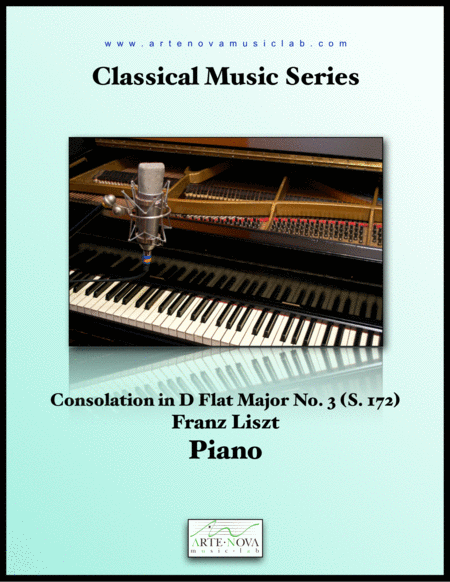Piano Solo - Level 4 - Digital Download SKU: A0.742468 Composed by Franz Liszt. Arranged by Arte Nova Music Lab. Concert,Romantic Period,Standards. Score. 7 pages. Arte Nova Music Lab #4412089. Published by Arte Nova Music Lab (A0.742468). The Consolations are a set of six solo piano works by Franz Liszt. The compositions take the musical style of Nocturnes with each having its own distinctive style. Each Consolation is composed in either the key of E major or D-flat major. E major is a key regularly used by Liszt for religious themes. There exist two versions of the Consolations. The first (S.171a) was composed by Liszt between 1844 and 1849 and published in 1992 by G. Henle Verlag. The second (S.172) was composed between 1849 and 1850 and published in 1850 by Breitkopf & Härtel, containing the familiar Consolation No. 3, Lento placido, in D-flat Major. The third Consolation is in D-flat major and initially marked as Lento placido. It is the most popular of the Consolations and also a favorite encore piece. Its style is similar to the Chopin Nocturnes, in particular, it seems to have been inspired by Chopin’s Nocturne Op. 27 No. 2. The similarity between the two works has been interpreted as a tribute to Chopin who died in 1849, a year before the Consolations were published. This third Consolation is however one of several of Liszt's works that take a style reminiscent of Chopin; some examples include Liszt's Polonaises, Berceuse, Mazurka brillante, and his Ballades. In 1883, years after composing the Consolation, Liszt received a Grand piano from the Steinway Company with a design that included a sostenuto pedal. Liszt began transcribing this Consolation for the new sostenuto pedal and in a letter to Steinway he wrote: In relation to the use of your welcome tone-sustaining pedal I inclose two examples: Danse des Sylphes, by Berlioz, and No. 3 of my Consolations. I have today noted down only the introductory bars of both pieces, with this proviso, that, if you desire it, I shall gladly complete the whole transcription, with exact adaptation of your tone-sustaining pedal. Liszt recommended sparing usage of the sostenuto pedal in the interpretation of this Consolation and opined on the positive effect it would have on the more tranquil passages. Notes taken from https://en.wikipedia.org/wiki/Consolations_(Liszt)#cite_note-
